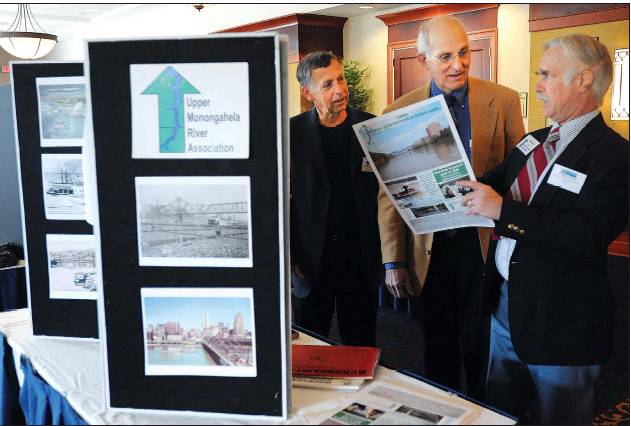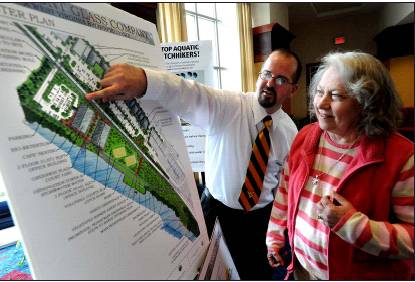Experts, Advocates Discuss Future of the Mon River
'It can positively or negatively impact the whole region'
Morgantown Dominion Post
14 April 2009
By Jim Bissett

Ron Rittenhouse / The Dominion Post
photo
Wally Venable (right) shows
Morgantown Deputy Mayor Don Spencer (center) and summit director Barry
Pallay some of the history of the Monongahela River at the Waterfront
Place Hotel on Monday.
Col. Mike Crall may have grinned a little at his
bureaucratic-speak Monday morning when he referred to the Monongahela
River as "aquatic infrastructure" —but that didn't mean he was kidding
when he said it.
"That's what I see." the officer with the U.S. Army Corps of Engineers
said as he regarded the river through the windows of the Waterfront
Place Hotel inn the Wharf District.
"It's an industrial resource," he said, it provides drinking water and
recreational opportunities. It can positively or negatively impact the
whole region."
And the acknowledgement of that was the reason for the gathering at the
hotel overlooking the Mon 's banks.
Experts and advocates turned out to talk about the politics and
particulars of the significant waterway. Running nearly 130 miles, the
river begins in Fairmont and links up with the Allegheny in Pittsburgh
to form the Ohio River.
Bass fisherman and jet-skiers share space with barges and tug-boats on
the river. which is a lot healthier now than it used to be. said Frank
Jernejcic, a fisheries biologist with the state Division of Natural
Resources.
"For years we were considered the most heavily polluted river in the
U.S. because of acid mine drainage." Jernejcic said.
Now the river is getting into the big-time bass tournament business,
with two marquee competitions in the works for the summer.
More than $15 million in economic stimulus money is also being stirred
into the water to maintain the network of locks and dams that aid in
water control and navigation, Crall said.
That's important. the colonel said. since the Mon is a major
transportation venue for shipping coal and limestone to power plants
from here to Pittsburgh.
Other fonts of commerce are coursing through the river as well, said
Ken Busz. president of the Morgantown Area Chamber of Commerce. The
Wharf District is a visible byproduct. he said. but he thinks the river
still has untapped potential.
"Right now. it's still an under-utilized resource." he said. "but it's
still a real focal point for the community."
Dashiell Harms didn't care about any of that Monday — the 9-week-old
snoozed in his carriage as his father, WVU English professor Jim Harms.
strolled down the Caperton Trail that meanders along the Mon.
Regarding the water that was reflecting an olive green on the gray
Monday. Harms said he liked the idea that people were in town talking
about the Mon's potential.
`I think they're probably doing as much as they can:' he said, "And it
is a nice river, in its own way.

Justin Burns, a landscape
architect student at WVU, shows Elizabeth Kyber. a visitor from South
Carolina. the proposal for Beaumont Glass Co. along the Monongahela
River in Morgantown.

